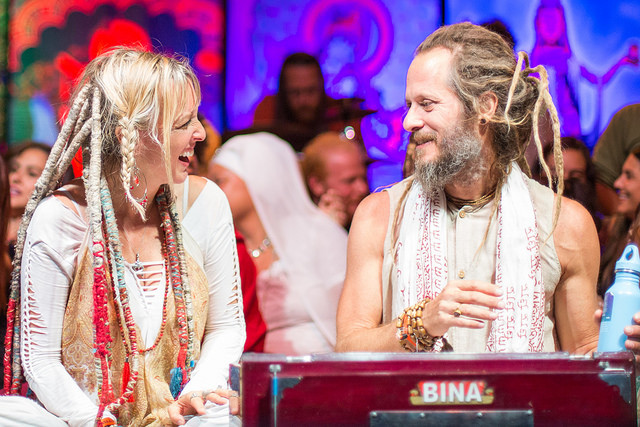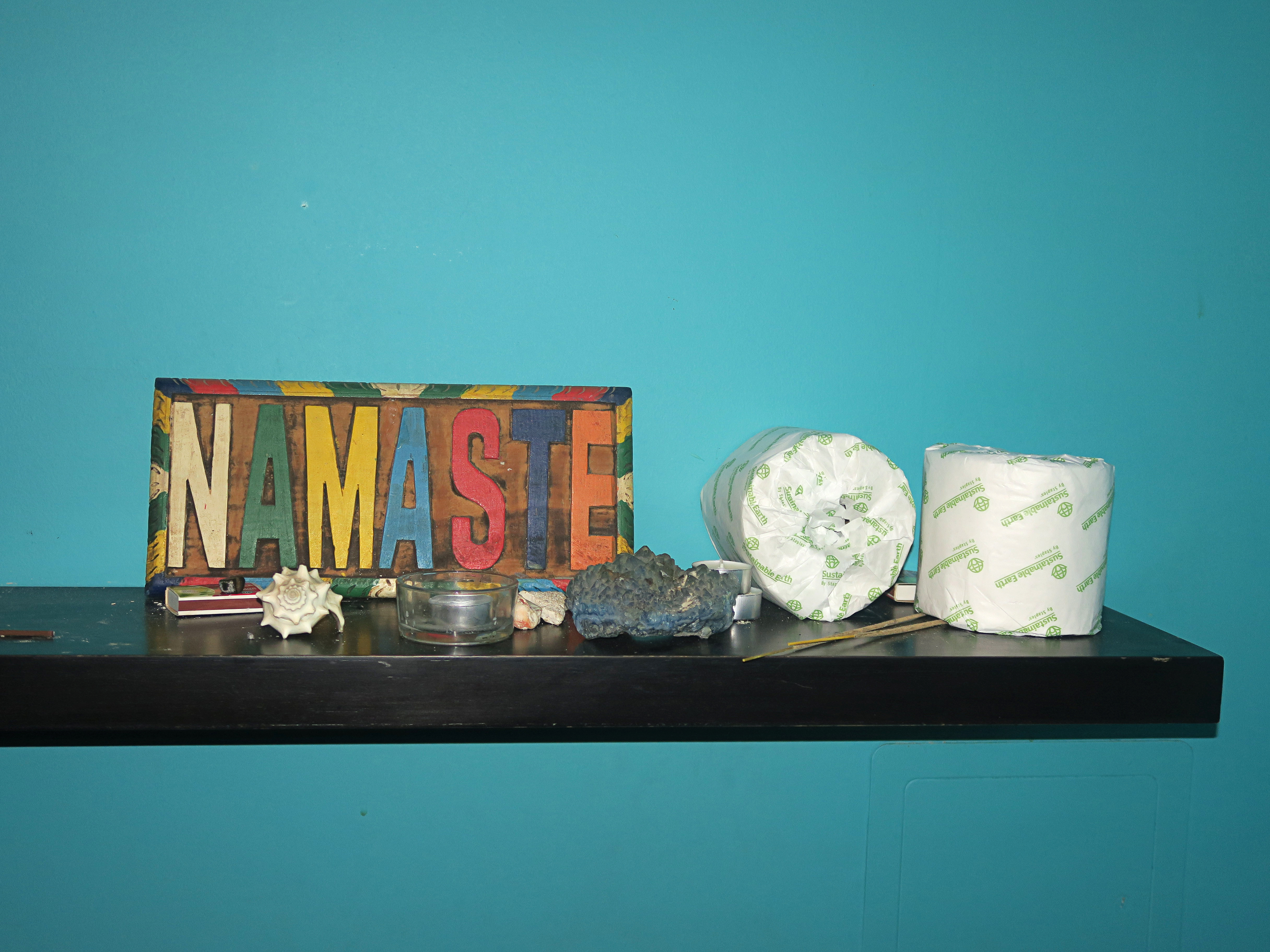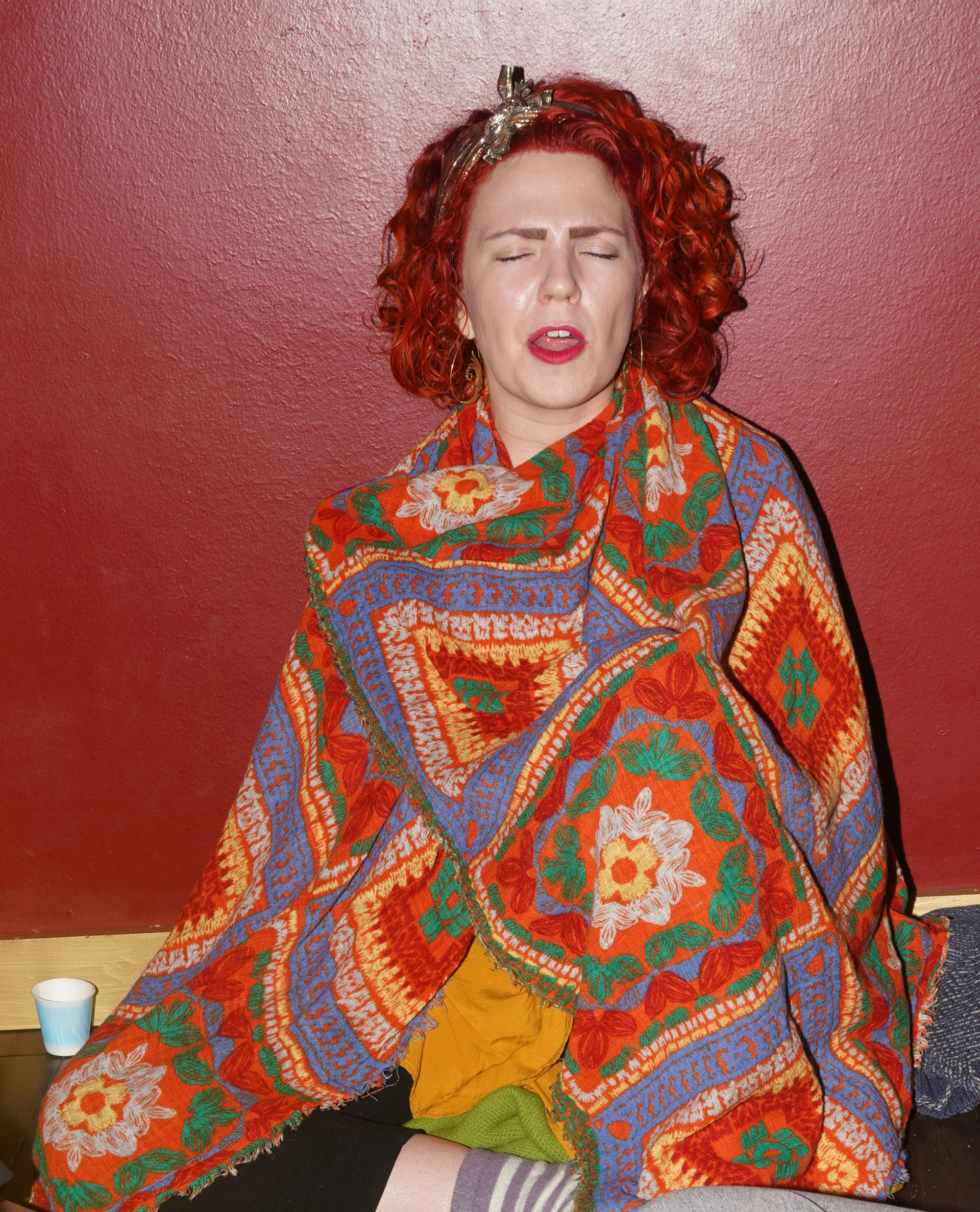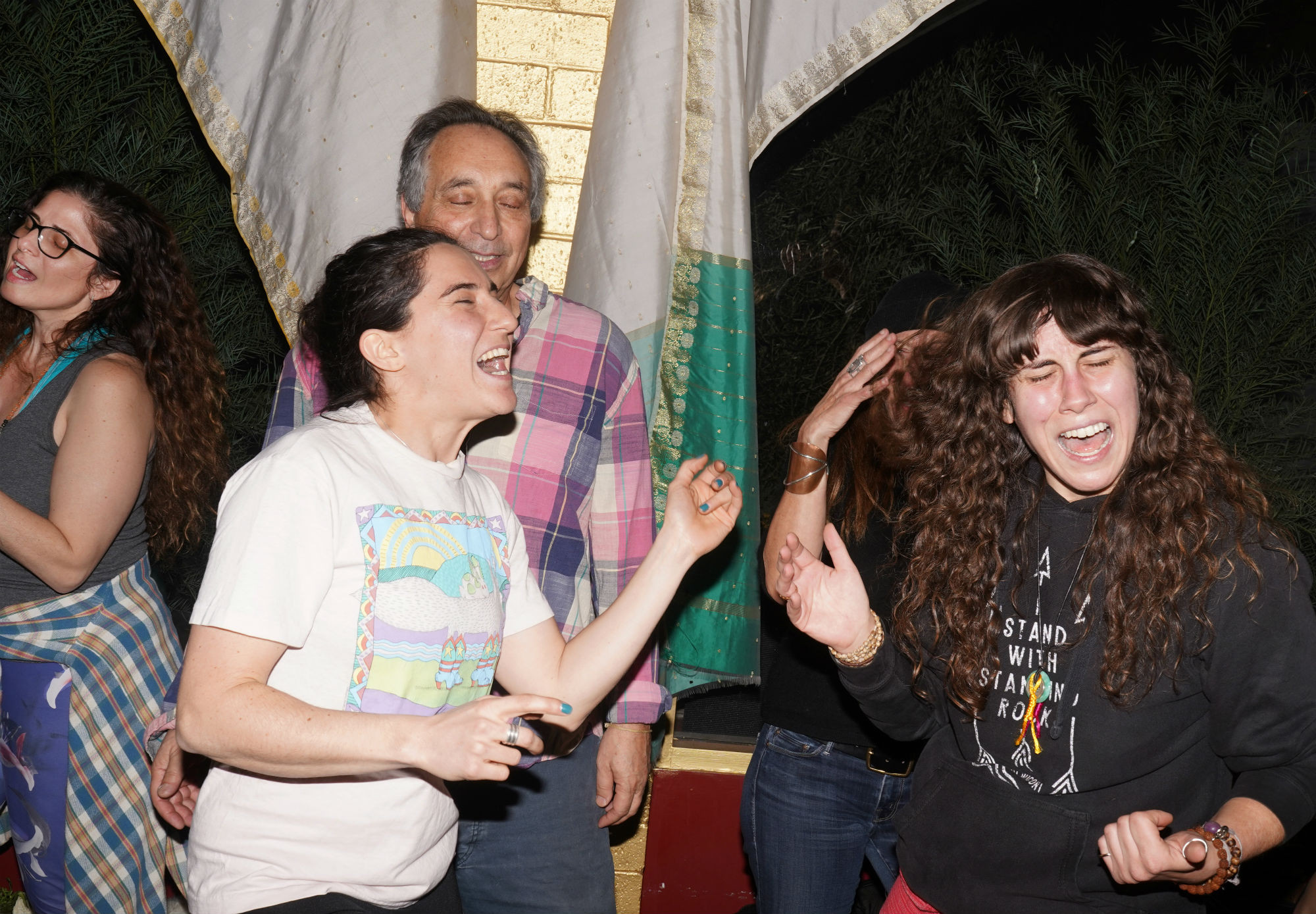
How LA Became a Bastion for People Who Are ‘Spiritual, Not Religious’
February 21, 2019In a little room near the ocean, five dozen people sit on the floor with their eyes closed. They are in lotus pose. Some lightly sway. A few hold their hands over their hearts, or raise their hands in the air, or do both. They clap along with a beat kept by a man in white linen playing a hand drum on the small stage at the front of the dimly lit space. They are deep in it—the prayer, the meditative bliss, the private interior place of sacred calm that’s easier to access when you close your eyes. My eyes are closed too.
Our mouths, however, are open, because everyone is singing. “Shri krishna sharanam mamah,” the crowd chants over and over, repeating the name of the Hindu God Krishna until the words achieve a hypnotic quality. In time the tempo picks up and the crowd stands, dancing and jumping up and down as the band—two drummers, a backup singer, a bass guitarist and a dreaded man on harmonium—hits its ecstatic peak. When the song subsides, everyone cheers. The temperature in the room has gone up ten degrees.
This is Monday night kirtan at Bhakti Yoga Shala, a Santa Monica yoga studio that since opening in 2009 has served as a primary hub for LA’s kirtan scene, an often barefoot spiritual music community that took root in Los Angeles more than 20 years ago and continues to thrive in yoga studios, private homes, and desert festivals around SoCal. In an expensive, competitive, lonely, dirty, and often abrasive city, kirtan is like hiking or going to the farmers market or driving fast up the PCH, in the sense that it makes life in Los Angeles more bearable for those who do it.
“Gathering together with people to sing, dance and open our hearts, for me makes Los Angeles the most amazing place,” says Govind Das, who was born in Maryland as Ira Rosen and is leading tonight’s kirtan. He, along with his wife Radha, founded Bhakti Yoga Shala. “Having spiritual community in Los Angeles is so important,” he continues, “because without it, it can be a very difficult place.”

Such earnestness can make people uncomfortable, but what Govind Das is describing isn’t so different than a night out at any LA nightclub, except the music here namechecks Shiva and Vishnu, the cover charge is cheaper (a suggested donation of $10 to $20), and everyone drinks coconut juice instead of alcohol. A practice said to have originated from the gods themselves, Kirtan—a Sanskrit word meaning “to sing, to praise”—is a Hindu tradition that exploded in popularity in 16th century India. Once done only by the priestly Brahman class, in this era kirtan was delivered to the people. For the first time, anyone with the desire could sing the names of the Gods and have a direct experience with divinity. Religious hierarchies were shaken as society realized the spark of consciousness existed in each individual. Plus, people just really loved singing.
Los Angeles-based kirtan pioneer Dave Stringer first went to India in the early 90s, finding that the transformative experiences he was having through yoga and kirtan blasted through the limitations of his rational mind. He was hooked, becoming, he says, addicted to the serenity-inducing neurochemicals that flood his brain while singing kirtan.
When Stringer returned to LA in the mid-90s, the city’s yoga scene was exploding, with Yoga Works—a studio then on Main Street in Santa Monica—taking a cue from nearby Hollywood and promoting its instructors like movie stars. While not without controversy, this marketing campaign turned teachers like Shiva Rea, Bryan Kest, and Seane Corn into yoga world celebrities. Stringer played their classes and was amongst a community of artists, performers, health enthusiasts and other myriad seeker types. It was the same far-out vibe of Laurel Canyon’s singer/songwriter scene of the 1970s infused with raga, Indian meditative practices, and ecstatic chanting.
“Suddenly the yoga scene had a soundtrack,” Stringer says. “People fleeing conventional religions still missed the experience of singing together.”
“We were all into world music,” recalls Donna De Lory, a songwriter and venerable kirtan performer who’s also toured extensively with Madonna. “I learned my first mantra, ‘Ganapati Om’ from Dave at one of his Hollywood Hills parties.”

Extending primarily out of Yoga Works and other independently owned studios in Venice and Santa Monica, this yoga/kirtan community extended the tradition of SoCal as a nexus for freewheeling spiritual exploration. Eastern influences had taken root in LA decades prior, with Sridhar Silberfein setting up his Center for Spiritual Studies out in Topanga Canyon in the 1970s. Here, heavies like Krishna Das, Jai Uttal, Bhagavan Das, and Ram Das—armed with knowledge gleaned from their gurus—shared Eastern mysticism with rapt Californians. (“California and Los Angeles are way ahead of the curve in most spiritual aspects,” Siberfian told me in an email from India.) Rick Rubin produced Krishna Das’ 2003 kirtan album Door of Faith, while George Harrison’s 1970 spiritual “My Sweet Lord” introduced mantra—“Hare Krishna, Hare Krishna”—to mainstream listeners.
The connection between India and Los Angeles that started when yoga first became fashionable in Hollywood during the 1930s has never really gone away. Kirtan has long been sung at the Hare Krishna Temple in Culver City. Meanwhile, Siberfian amalgamated the practices that transformed him from Steven of Long Island to Sridhar of Topanga into Bhakti and Shakti fests. Happening each fall and spring in Joshua Tree for the last decade, these festivals—“the Coachellas of kirtan”—are major gatherings for the SoCal scene, with thousands of acolytes arriving each weekend to dance, sing, meditate, burn sage, spin around in circles, and stretch.
“More and more people each year are coming to LA craving authentic community in a landscape that has such a reputation for fakery,” says Shiva Baum, a music producer and Head of Music Programming at Bhakti Fest. “Add to that the historically strong yoga practice in studios all over town, constant teacher trainings and the greatest kirtan venue in North America [Bhakti Yoga Shala] and you have the recipe for a thriving movement that’s showing no signs of slowing down.”

Larisa Stowe has headlined Bhakti and Shakti many times. Based in Long Beach, she was an accomplished LA singer/songwriter until 9/11 redirected her path. “I just lost my desire to continue singing in that secular Hollywood environment,” she says. “I felt this desire to dive into prayer.” She found kirtan and quickly rose through the scene, finding a community—“my peeps, my tribe”—more in sync with her values. It was then as it is now—healthy, friendly, genuine and largely free of music industry posturing. Like Stringer and De Lory, Stowe tours the United States playing kirtan at yoga studios, festivals, and venues, and also did a series of shows at the Men’s Central Jail in downtown Los Angeles. After one of these “peace concerts,” Stowe got a call from a former inmate.
“He told me he had gotten out of jail, went on to a deep yogic path and met his girlfriend in a yoga studio,” Stowe recalls. “Kirtan had completely transformed his life.”
Indeed, despite its reputation for vapid superficiality, Los Angeles is also weirdly and wonderfully deep. One seems to demand the other. Unlike many of the crowds at fancy parties and nightclubs and Soho House, people in the kirtan scene are nice, sometimes aggressively so. They smile at you when you walk in the room, make eye contact, and end their emails with salutations like “blessings” and “all love.” Certainly there are hucksters and charlatans in this so-called “conscious community,” but at least most of them put their phones down while you’re speaking.
Angel Cantu has also found community through kirtan. A yoga instructor at Bhakti Yoga Shala, Cantu says she had a hard time “authentically connecting” with people when she first moved to LA from Washington state. Alone on New Year’s Eve 2015, Cantu Googled “yoga near me” and saw that Bhakti Yoga Shala was having a seven-hour kirtan to ring in the new year. She went alone, finding great affection for the music, the atmosphere and the babies asleep in the arms of their mothers as the clock hit midnight.

“I found my people here,” she says, “my community, my practice, my partner, my livelihood.”
In fact there’s science behind why kirtan so profoundly moves its participants. At its most fundamental level, the practice causes a large group of people to breathe in at the same time and rate, which, Stringer says, “causes people to link up in certain interesting ways.” As social creatures, humans have both a biological ability and imperative to link in this way. “That's part of what's powerful about kirtan,” Stringer says, “because people who can sync up can cooperate. People who can cooperate are able to survive.” Meanwhile, the neurological effects are simultaneously calming and thrilling, an experience similar to sex.
Stringer's notion of survival perhaps reveals the key to kirtan’s popularity in Los Angeles, where just getting across town during rush hour can be a lesson in existential malaise. (“A friend of mine in LA calls kirtan the best cure for road rage,” Stringer says. “There are a lot of people driving around on the freeways chanting.”) Tech-industry driven gentrification has largely forced the hippies out of Venice and Santa Monica, where juice is now $19 and most yoga doesn’t involve singing. Yoga Works, the former center of the scene, was sold and turned into a corporate chain. But there are still a lot places to find kirtan in Los Angeles. A hard city requires potent antidotes. (“Bhakti Yoga Shala is for Kirtan what the Fillmore East and West were for the '60s rock and roll hippie revolution,” says Baum. “It is ground zero for the movement.”) Stringer emphasizes that one need not believe in God for kirtan to work. If you’re willing to just sit down and sing, your body and brain will respond in a way that has more to do with physiology than spirit.

“In chanting these mantras,” says Govind Das, whose mellow vocal tone emphasizes his point, “the presence of fear, anxiety, and worry has been replaced with faith and trust that everything is unfolding in cosmic order, exactly as it should.”
Los Angeles can be an anxious city. It’s scary to wonder if you’ll ever achieve the dreams you moved here in pursuit of, to pay thousands of dollars in rent, to compare yourself with others who seem to achieve more, to see the homeless encampments downtown, the plastic garbage washed up on the shore of Venice Beach, the fire smoke rising out of the canyons. To believe in cosmic order in Los Angeles can feel absurd, self-indulgent, the directive of someone just singing with their eyes closed. But when I leave the kirtan, I do feel better, more grounded and less distracted by thoughts of my past and hypothetical future. In a city fueled by the rise and falls of trends, it's not hard to see why kirtan has maintained a steady presence all these years, and why people still seek it out today.
Sign up for our newsletter to get the best of VICE delivered to your inbox daily.
Follow Katie Bain on Twitter.


